Many teachers have already reorganized our leveled libraries because we learned that, according to Fountas and Pinnell , “levels have no place in classroom libraries.” Sorting books into bins labeled by theme or topic is time-consuming, but it’s not a difficult task. We immediately see that offering students more choice in their reading materials and teaching them to monitor their own reading for accuracy and comprehension is rewarding. However, books at the lower levels, “predictable books,” pose a challenge that is not so easily solved.
Problems with predictable books
Predictable books are designed to teach children not to depend on decoding to tackle unfamiliar words — they are purpose-written to teach children to predict, or guess words — so what children do with low-level books is not actually reading. Some students climb up the levels by transitioning away from picture-cues and predictable sentences, but others hold tightly to the guessing strategies that are reinforced by predictable books, and time with these books actually slows their decoding progress. For beginning readers, decodable books provide a more reliable path towards authentic texts, and using them for phonics instruction and fluency practice offers a “helps all, harms none” approach to teaching reading. But what, then, should we do with all our predictable books?!
Rethinking the instructional purpose
To repurpose predictable books for activities other than reading, we need to look at them with fresh eyes and new criteria. More important than the level stamped on the back cover is the contents inside.
We can ask ourselves, What are the features of this individual book that make it a useful teaching tool? A single book may have more than one useful feature and it might be repurposed for any number of language development, writing, or art activities.
We’ve listed out some of the features you might look for in predictable books and have drafted example activities to help with lesson planning.
Predictable book types
| Types | Activities | Examples |
|---|---|---|
|
Single sentence per page with a single story word |
1. (Re)Write the Book |
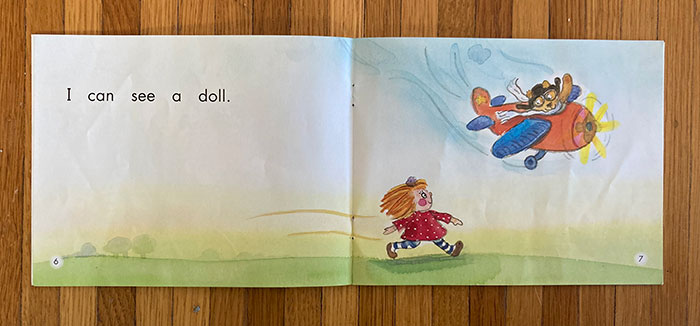
|
| Pictures that tell an interesting story |
2. That’s a Different Story |
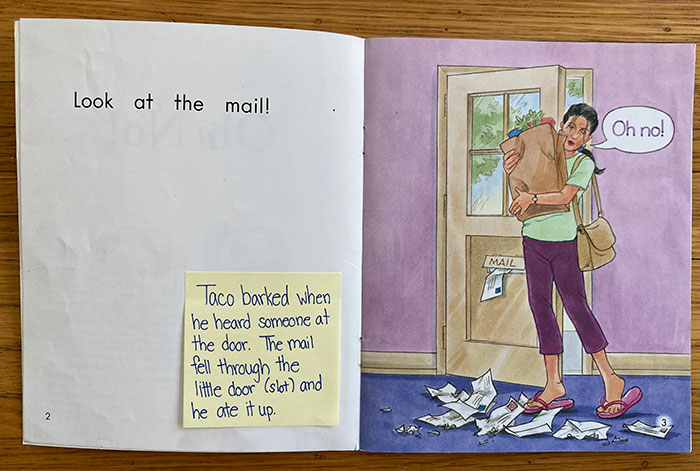
|
| Pictures with multiple characters |
3. What’s That You Said? |
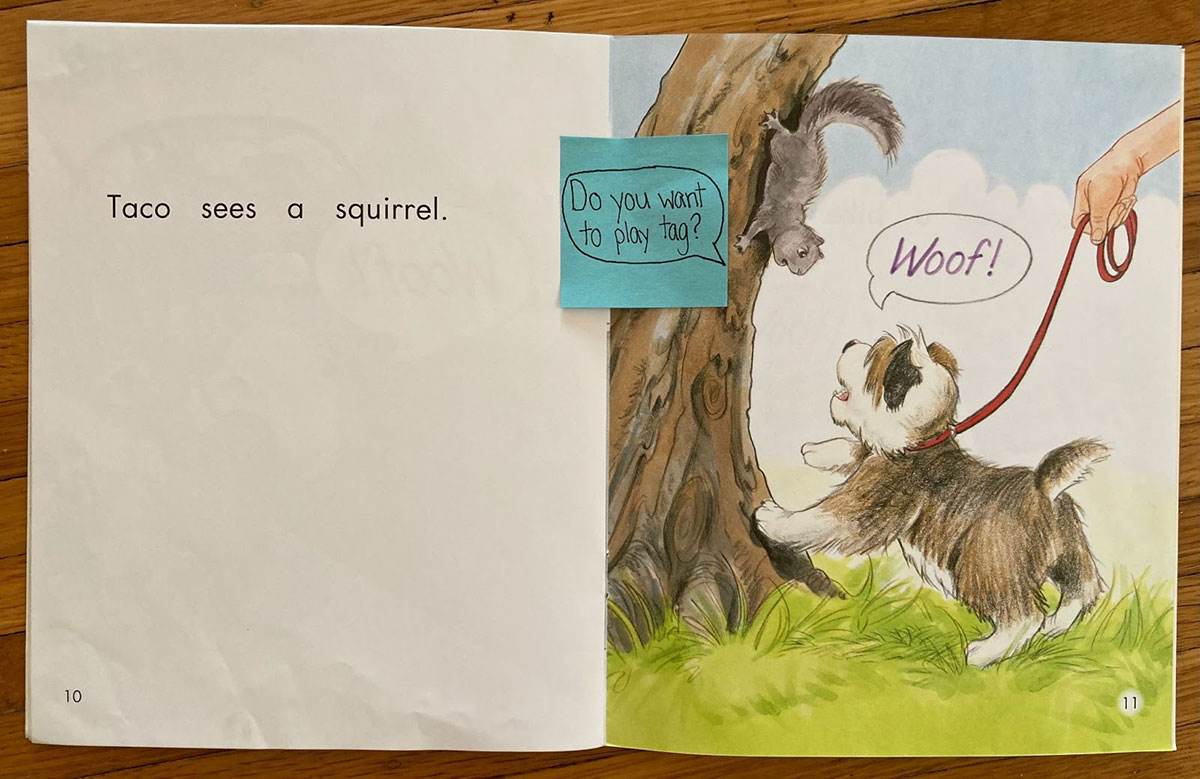
|
| Paired texts with the same subject |
4. Putting the Parts (of Speech) Together |
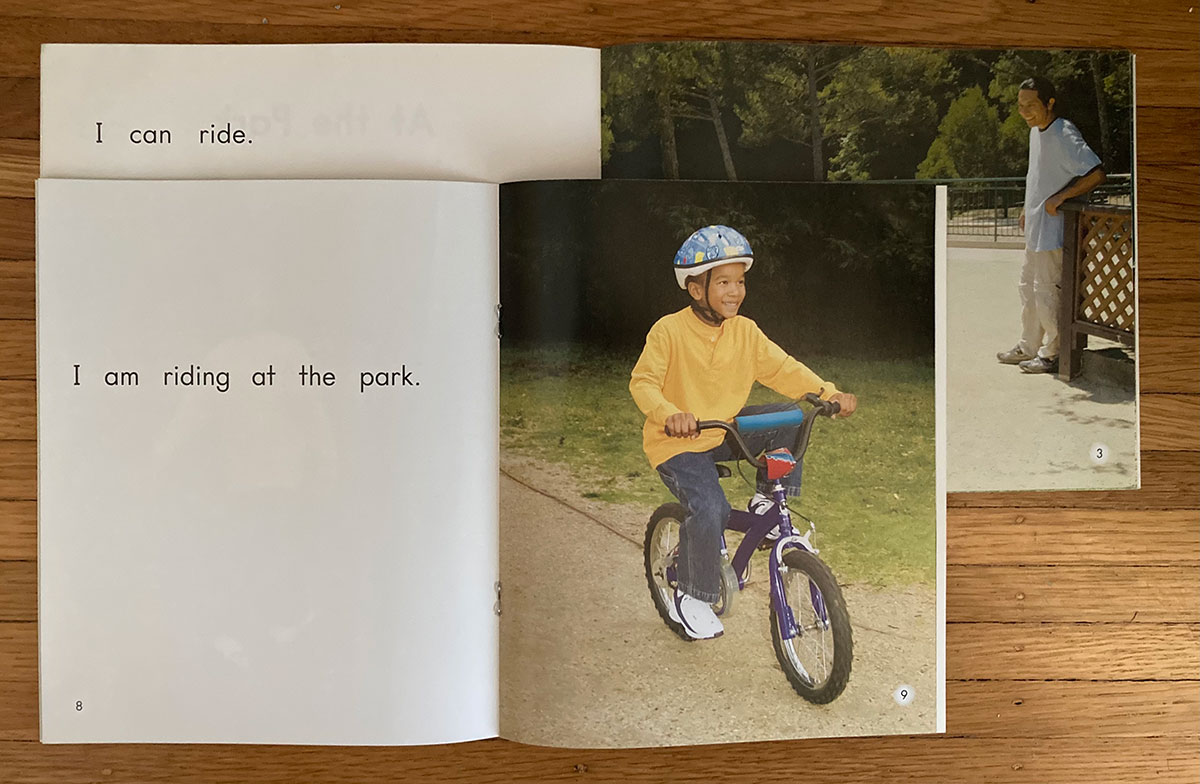
|
| Paired sentences |
5. Take Two |
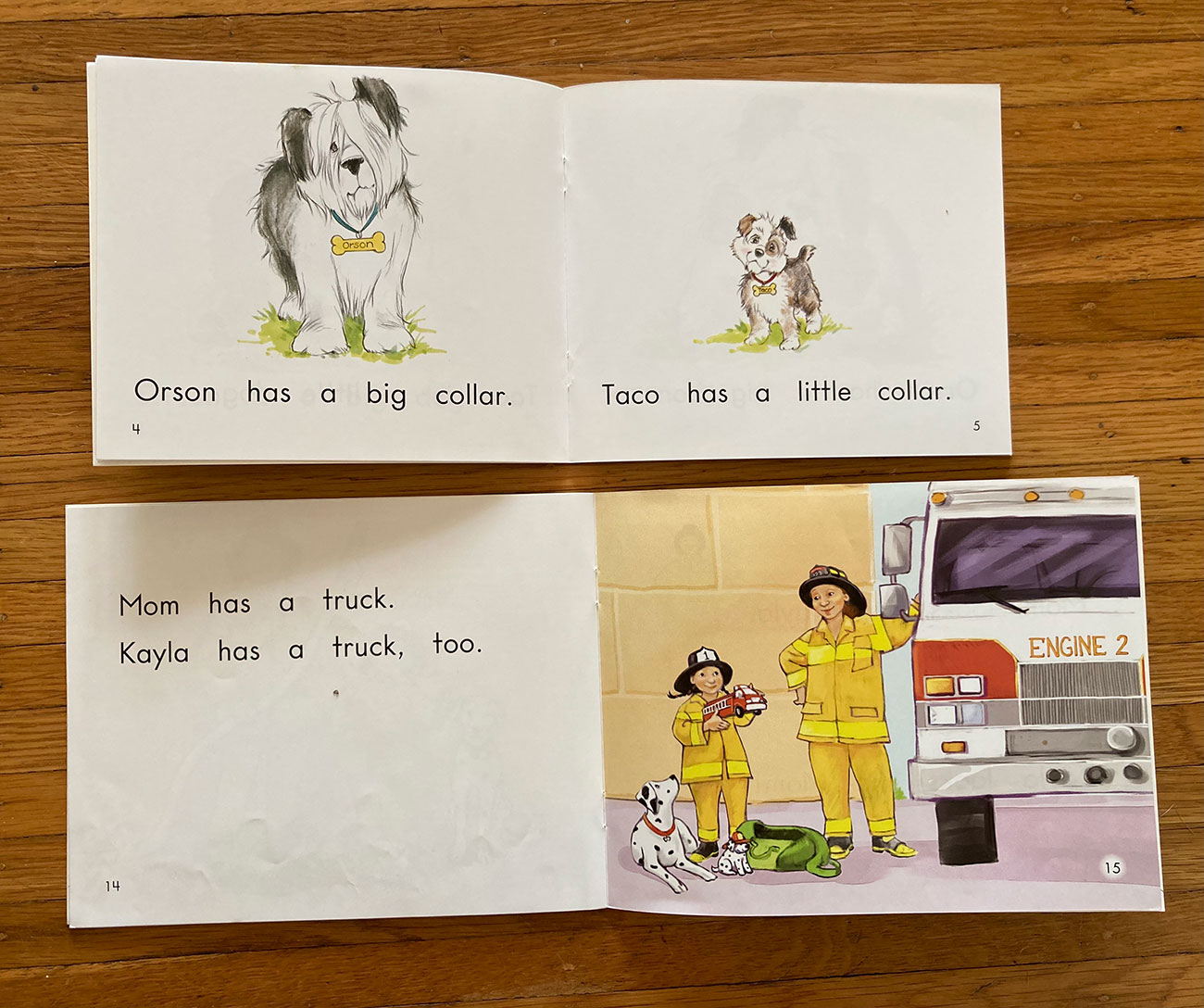
|
| Big books |
6. A Big Improvement |
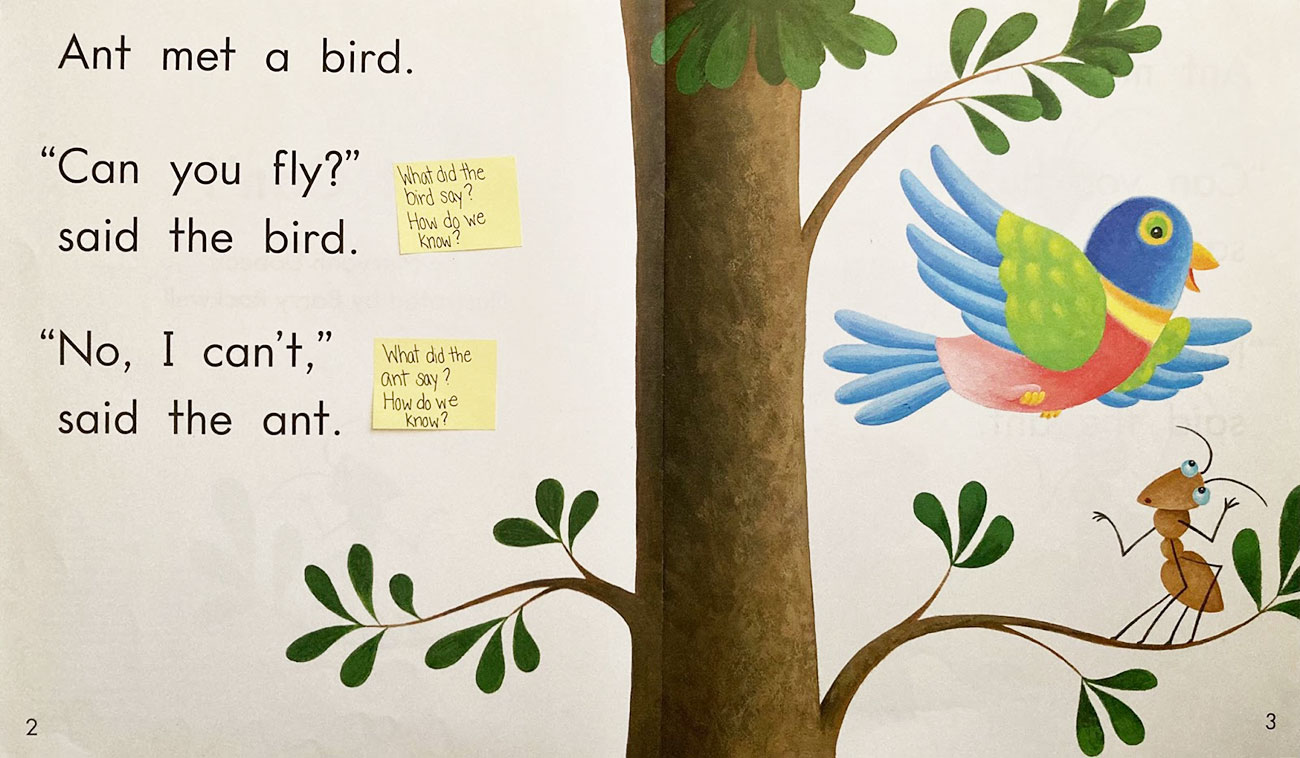
|
| Single sentence per page with taught high-frequency words |
7. You Can Spell That Again! |
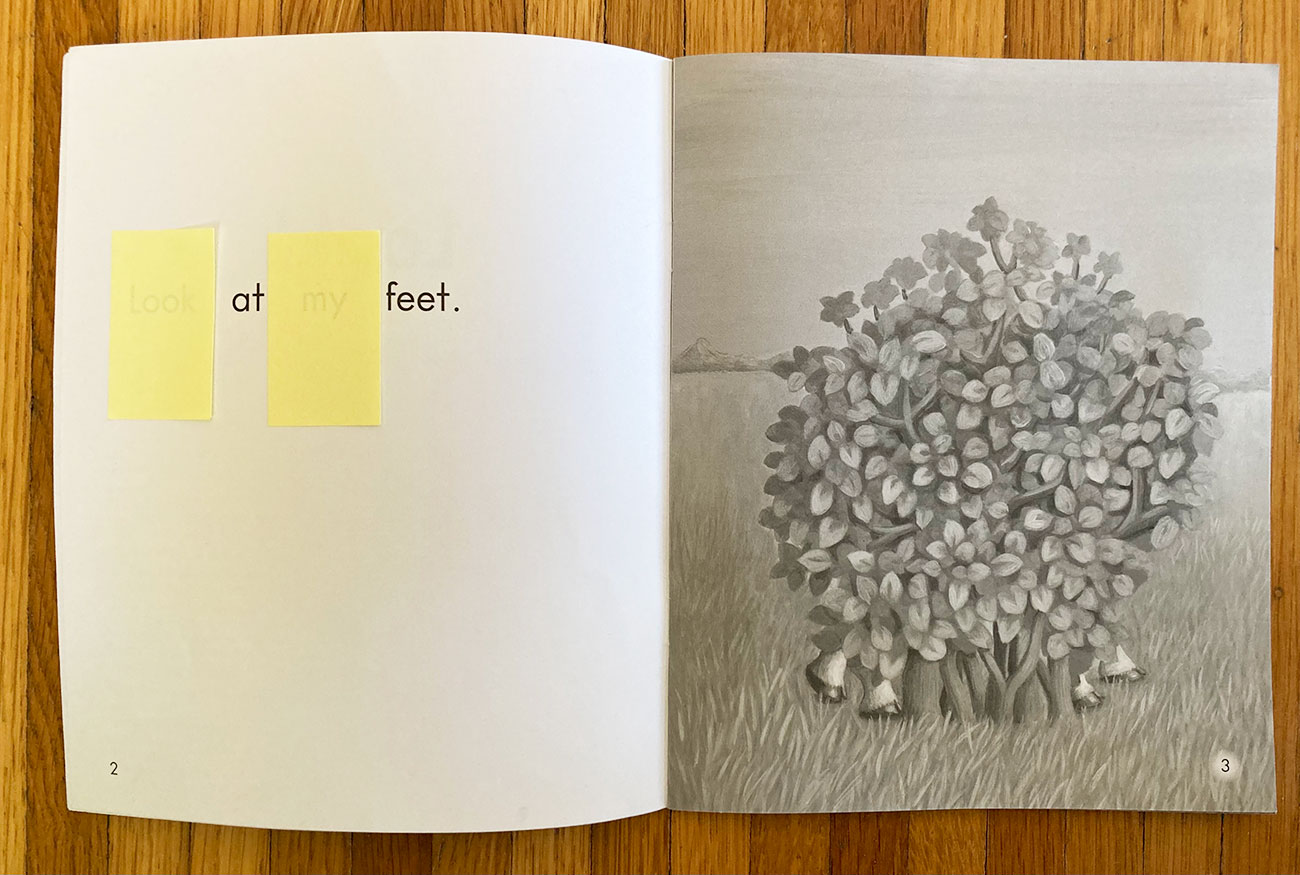
|
| Cumulative illustrations | 8. Talk and Turn the Page Language Development for Beginning English Learners |
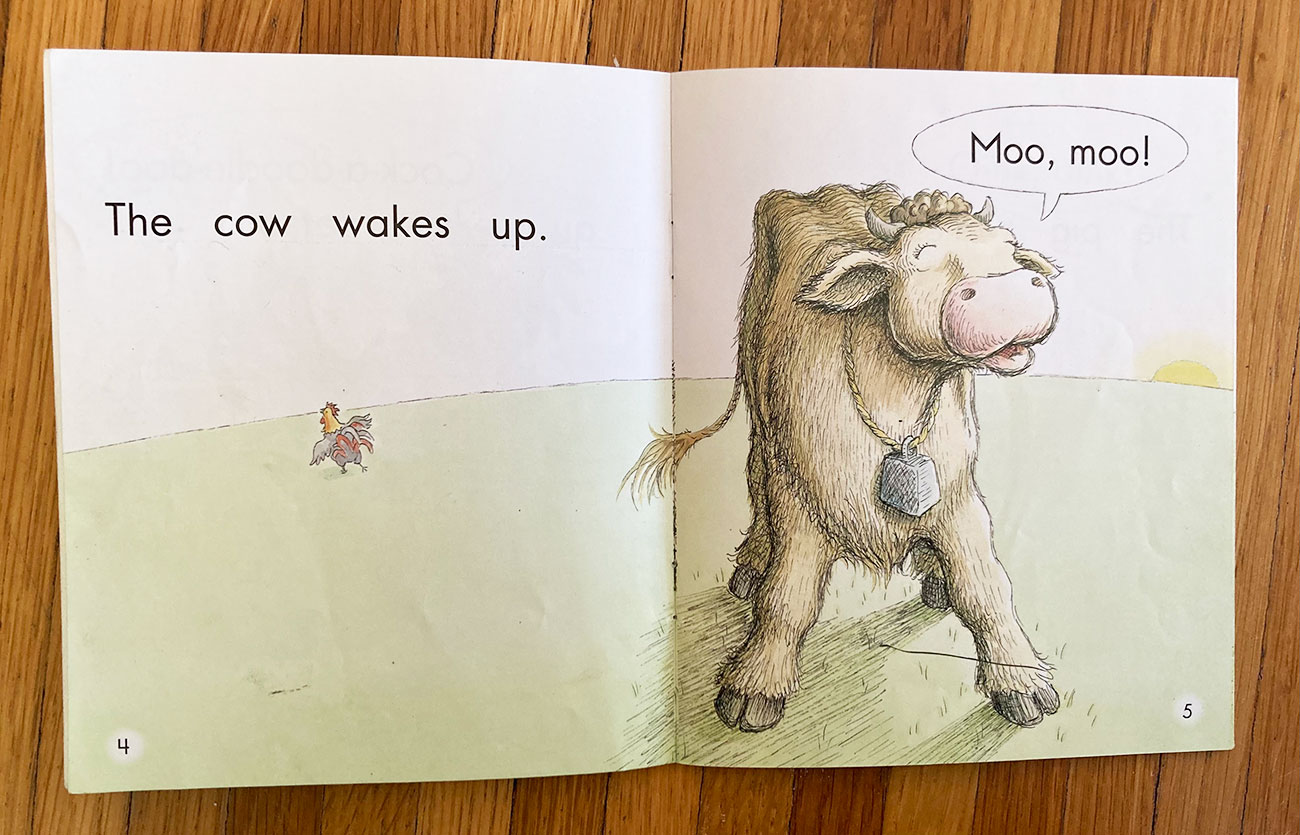
|
| Obvious pictures | 9. Picture This Vocabulary Picture Cards |
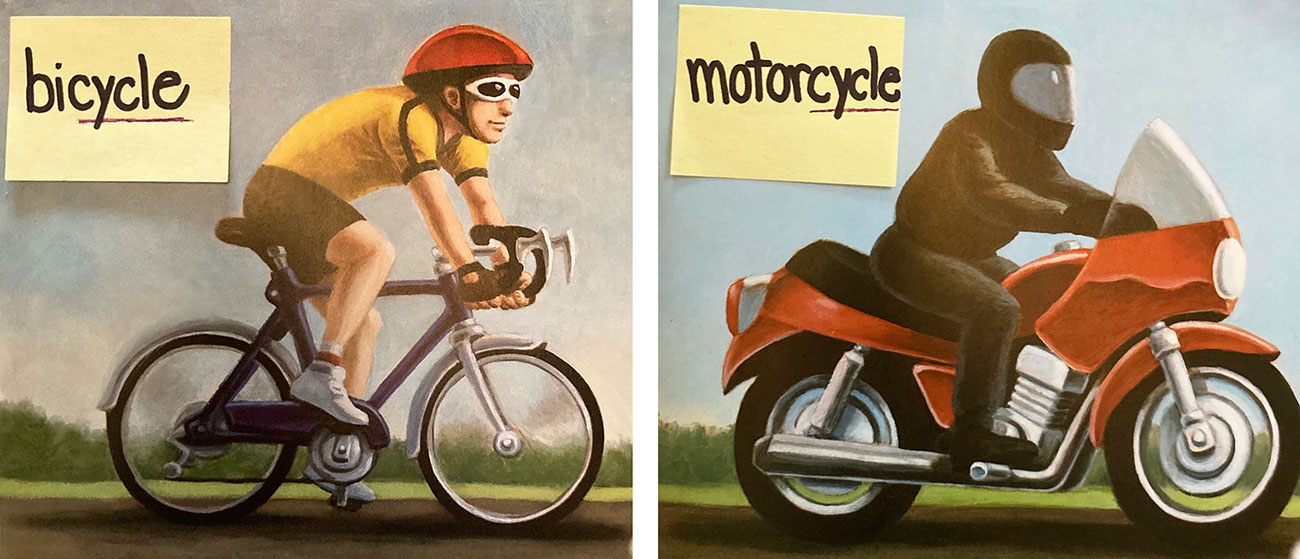
|
| Themed text sets | 10. A (Labeled) Picture Is Worth a Thousand Words Labeled Collages |
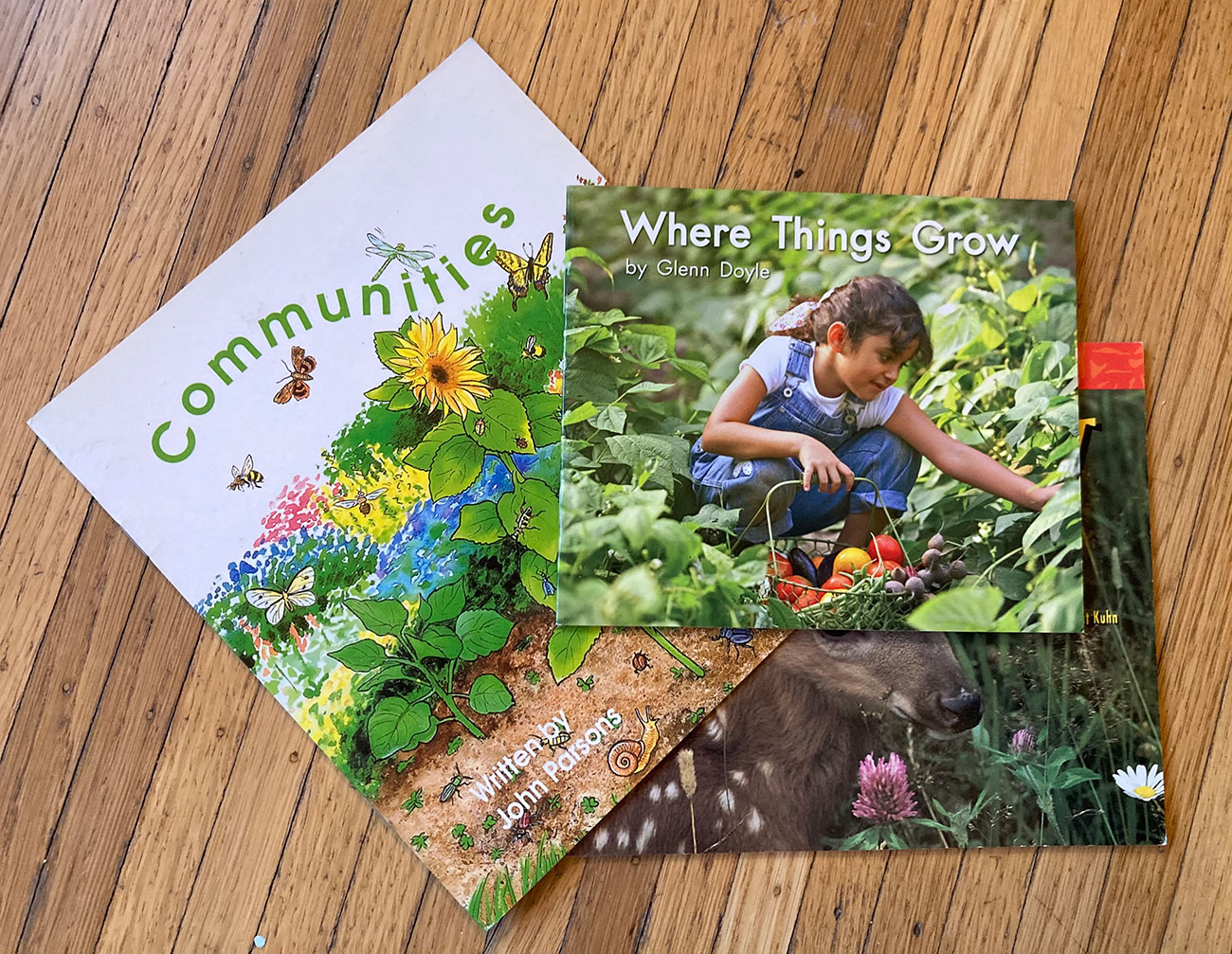
|
1. Re(write) the book
In the Level A book below, the pattern is I can see a [story word].

Using Post-it® tape, cover all words except for the story words. Covering the punctuation and extending the tape on the other side of the story word will allow for more flexibility in student-generated sentences.

Model the activity by thinking aloud about a sentence that describes the first page of the book. Have students repeat back the sentence you say. Using the tools available to students in the classroom (word wall, sound spelling-cards, etc.) have students “help” you write the sentence.
For subsequent pages, encourage students to be creative in their sentences so that they get the opportunity to apply a variety of high-frequency words and phonics to compose a book that is more interesting than the original.

As students develop more independence and confidence with the activity, rewriting books can become a Literacy Center or independent activity.
Post-it® tape is removable, so the same book can be used by multiple students. Different versions of the same book may make for a fun series in Author’s Chair .
2. That’s a different story
Depending on your students’ writing abilities, you can invite them to dictate a story they infer from the pictures or they can rewrite the book themselves.
To begin the lesson, read the book aloud while showing the pictures. (Consider using a document camera to ensure all students can see.) At the end of the story, have students turn to a partner to talk about what happened in the story. Allow enough time for the partner discussion so that students feel compelled to elaborate.
Allow a few students to share their thinking with the whole class and, as they do, flip to the illustrations that correspond with what the volunteers share. Point out features of the illustrations that support what students say.
Explain that most of what students said about the book came from the illustrations because the words don’t do very much to help the story. Tell students that the book deserves new words and that they are going to decide what the words will be.
For dictation, display the first illustration and ask students to turn and talk with a partner to tell what happened (or is happening) in the picture. Select one student to share with the class as you transcribe what they say. You can take the dictation on Post-it® notes directly in the book or write on chart-paper and invite students to help you sound out or write some of the words. Repeat this procedure for the remaining illustrations. Then, read the newly written story aloud to the class.


If your students are able to complete the writing independently, you can give them booklets to write in (with or without photocopied illustrations) or simply a sheet of lined paper. To scaffold the activity, you can display the first page of the book and model where in the booklet or on the sheet of paper students will write. The whole class can write one story, students can be encouraged to write their own versions, or a combination of both (some students writing independently, others engaging in guided writing) might be best to address the various writing abilities of your students. Depending on how much time is available after the activity, students can share what they wrote for one page or for their whole book.
3. What’s that you said?
To introduce this activity, read the book aloud and allow students time to see each illustration. (Projecting the book with a doc cam works well for this.) Then, flip back to the first illustration and ask students to share what they notice about the picture.
Once a few volunteers have had time to share their observations, prompt students to think about what the characters might be saying or thinking. For example, you might say “Taco is saying ‘Woof!,’ but I wonder what the squirrel is saying.”
As a volunteer shares an idea, record the thought inside a speech bubble drawn on a Post-it® note. Explain the function of a speech bubble — it lets the reader see the exact words a character is saying so they can imagine the conversation. Position the speech bubble on the picture and then reread the page.
For subsequent pages, invite students to share what they believe a character might be saying. You can have them dictate to you or they can make their own speech bubbles on Post-it® notes. You might even consider having them write directly in photocopies of books.

Depending on students’ level of language development and experience with comic-style texts, you might use the opportunity to teach the difference between speech and thought bubbles and then incorporate thought bubbles into the activity.
4. Putting the parts (of speech) together
Multiple books on the same topic or with similar predictable patterns make good use of a GLAD Sentence Patterning chart because the same chart can be added to during a series of lessons.
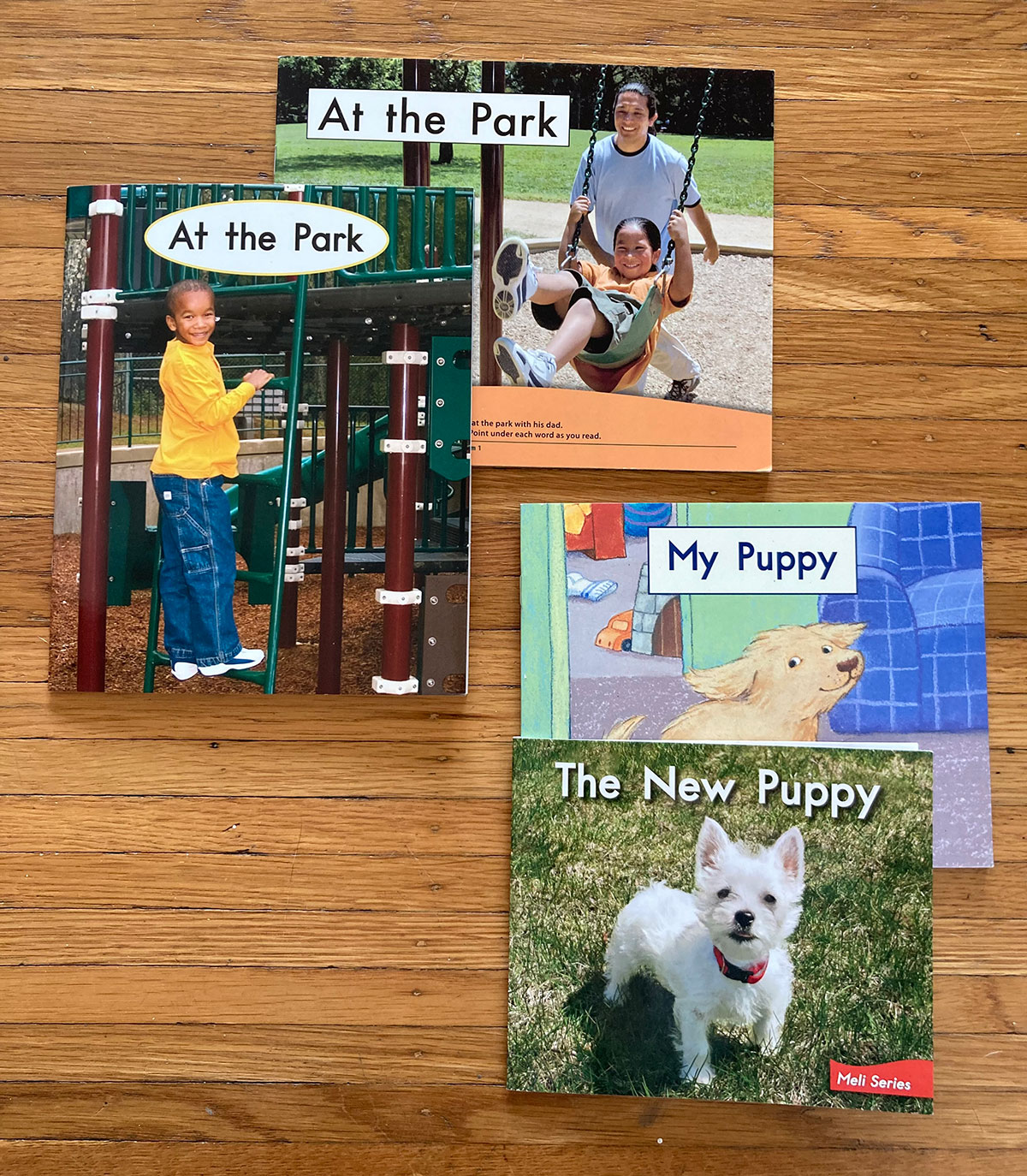
Both books titled At the Park are Level A, but the language demands of the two texts are quite different. One book follows the pattern I can [simple verb], where the present tense verb is the story word. In the other book, the story words are gerunds (swinging, riding) that are part of verb phrases (am swinging, am riding) and the verb phrase is followed by the prepositional phrase “at the park.”

Modeling how to add on to simple sentences can help students construct more precise sentences both orally and in their writing.
The first lesson
Using a GLAD sentence patterning chart, show students the parts of the sentences that remain the same from page to page (in At the Park the noun and subject of the sentence, I, is constant) and the parts that change from page to page (the verbs of At the Park change; swing, ride, kick).
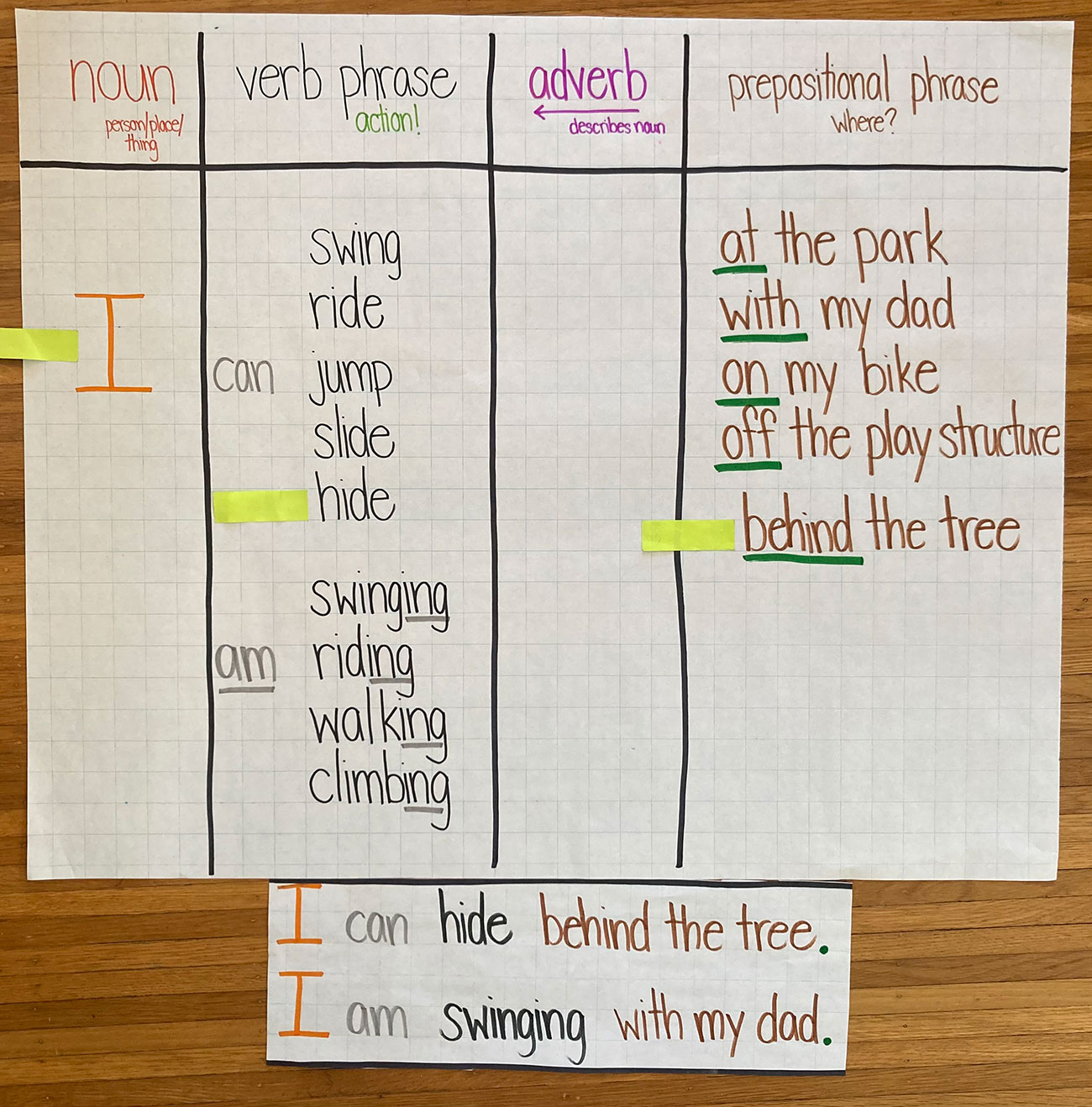
Sentence patterning chart
Have students share ideas for how they can add to the simple sentences. For some books, it might make sense to add adjectives or adverbs. At the Park works well for exploring prepositional phrases (“with my dad”, “on my bike” “off the play structure.”)
Record students’ ideas on the sentence patterning chart (see above) and/or use Post-it® notes to add directly to the book (see below).
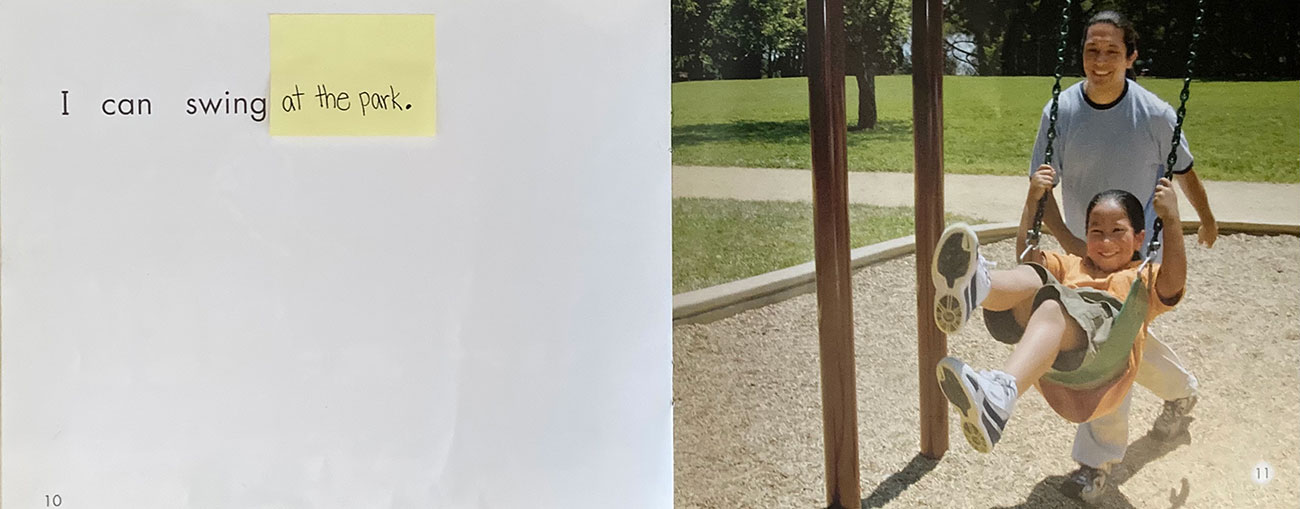
Students can use the Sentence Patterning Chart to say, write, and draw fun new sentences. A student volunteer can use a Post-it® note in each column to flag the components of the chart that they would like to use and then speak their complete sentence aloud. For example, students might construct:
I jump with my dad.
I ride off the play structure.
I slide on my bike.
The subsequent lesson
Display another book on the same topic or with a similar grammatical structure. Have students share the similarities they see between the two books.
If the sentences in the second book are more complex than the first, point out and explain the differences. For example, in the second version of At the Park, the prepositional phrase [“at the park”] remains the same, but on each page there is a new gerund [swinging, riding, jumping]. Explain that the verbs have the ending -ing because they come after the word “am.”
Provide the rationale for the grammatical structure, for example ,“In this book, the boy tells what he does at the park at the same time he is doing it.”
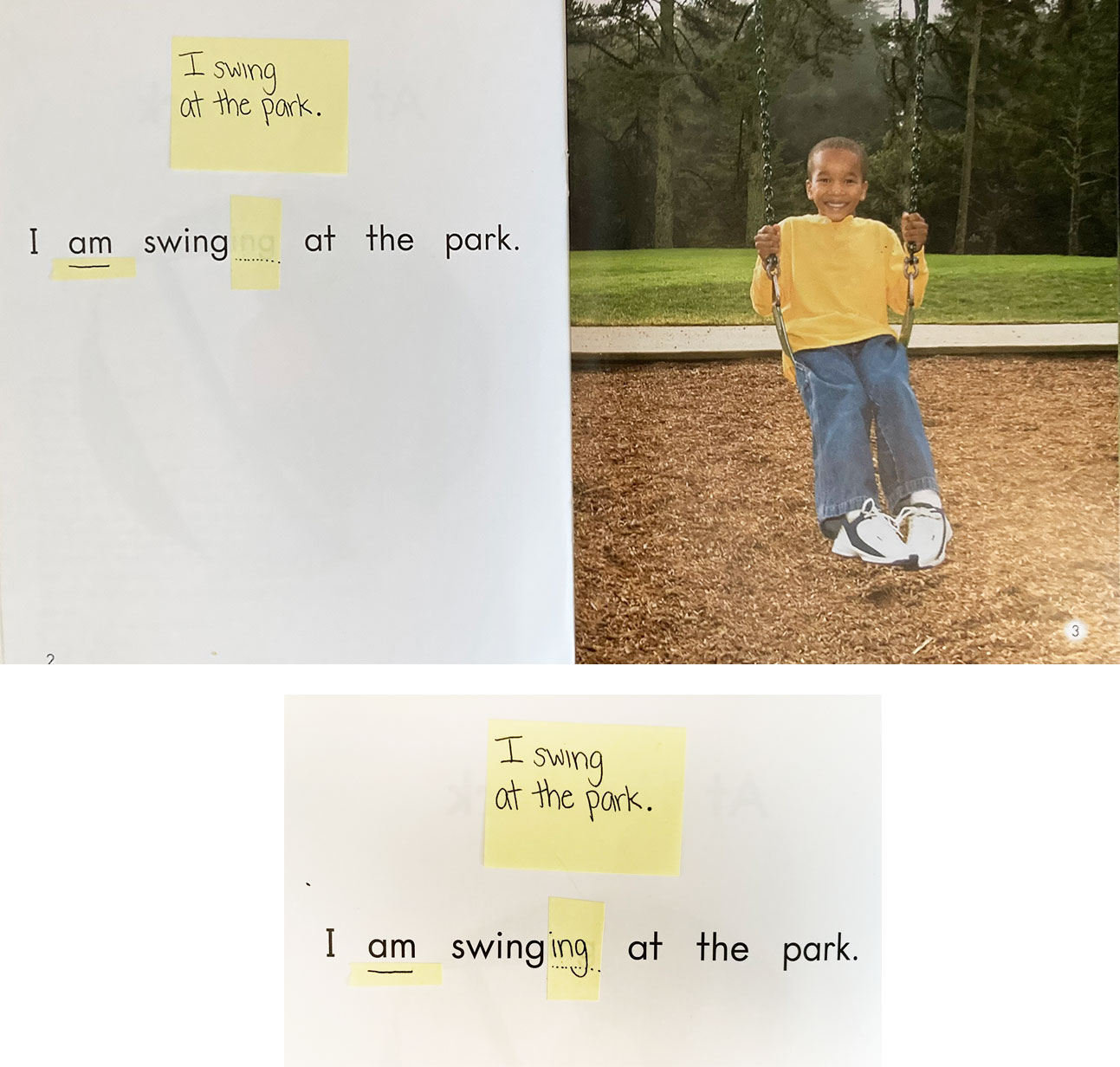
Read the book aloud while adding the new words to the Sentence Patterning Chart. Students can then use any grammatical combination from the chart to say, write, and draw new sentences.
I am jumping with my dad.
I am hiding behind the tree.
I am sliding off the play structure.
The new sentences can be used to create a class book or each student might write their own to add to the classroom library.
5. Take two
Sentence combining works best with books that have paired sentences, usually two parallel sentences found on each spread or page.

In the Level A book Friends, the paired sentences are across each spread:
Orson has a big [story word]. Taco has a little [story word].
In the Level B book, Mom and Kayla, the paired sentences are on a single page:
Mom has a [story word]. Kayla has a [story word], too.
Determine the grammatical construction you’d like to teach to build upon your students’ oral or written abilities.
Examples
Adding a conjunction to link the sentences
- Simple: Orson has a big [story word] and Taco has a little [story word].
- Complex: Both dogs have [plural story word], but Orson’s is big and Taco’s is little.
Replacing a repeated noun with a prop word
- Orson has a big [story word] and Taco has a little one.
Adding pronouns to generalize
- Simple: Both of them have [plural story word].
- Complex: Both of them have [plural story word], but they are different sizes.

Write the sentence frame on a sentence strip or chart paper, but do not display it in the first steps of the lesson.
Begin the lesson
Show a page or spread from the predictable book. Point to and read a sentence pair aloud.
“Orson has a big collar.”
“Taco has a little collar.”
Have students discuss what is the same and what is different about the two sentences. You might write down what students share.
For example:
“Both sentences talk about dogs and their collars.”
“Both sentences say, ‘__ has a __.’”
“One sentence is about the big dog and the other is about the little one.”
Model by thinking aloud about how to combine the two sentences.
Write your combined sentence on the board and have students chorally recite the sentence with you, as you point to the words.
Discuss whether and how the combined sentence retains the meaning of the original sentences.
Display the sentence frame and have students read it chorally with you.
Show a new spread in the predictable book and invite a student to complete the sentence frame with the new story word(s).
Repeat this procedure until all students have had sufficient practice and can say or write a sentence with the grammatical construction you’ve taught.
6. A big improvement
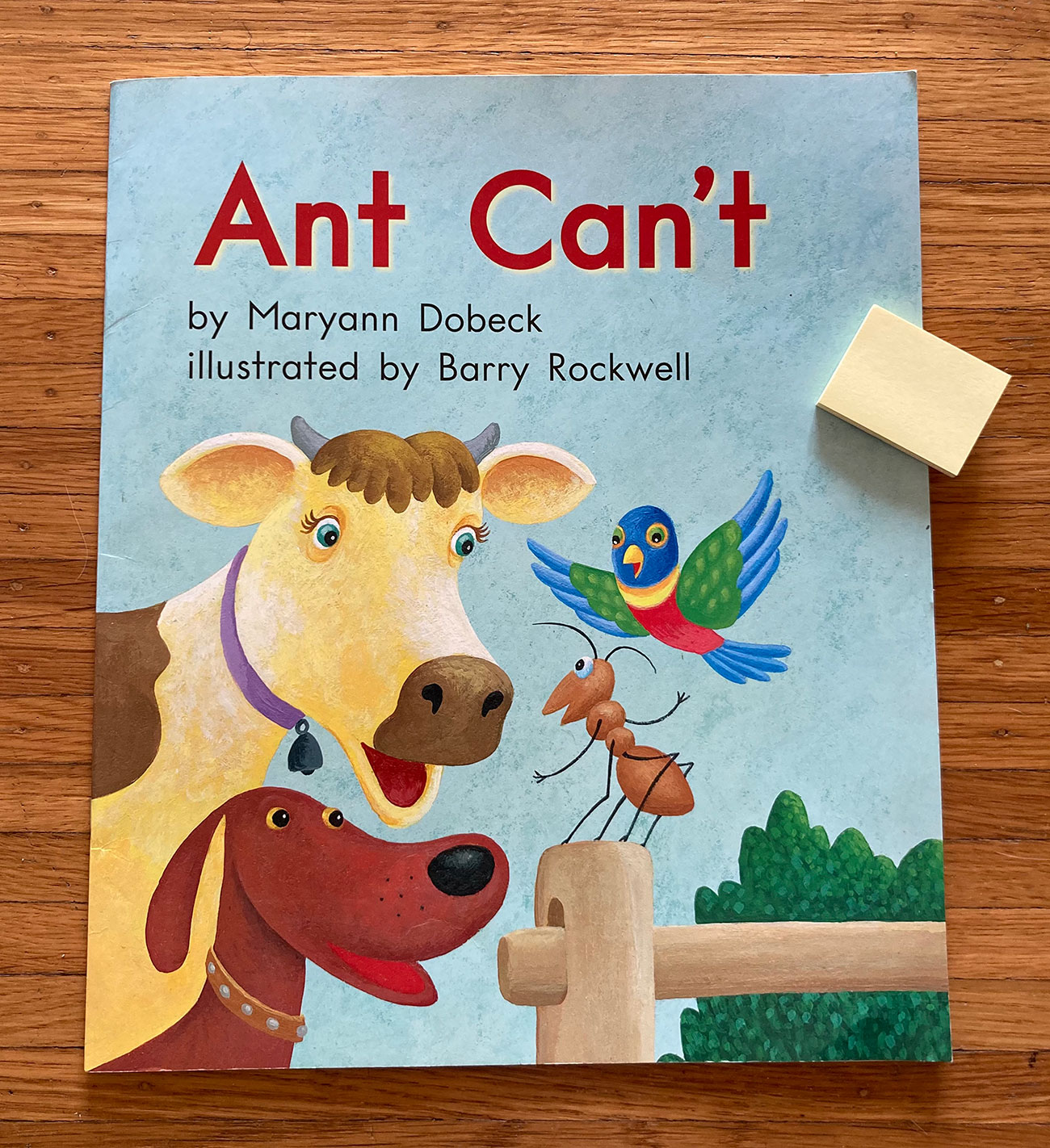
Prepare the text prior to your lesson by writing the questions you will ask and the engagement strategies you will use on Post-it® notes, which you can place on the appropriate pages of the book.

White Post-it® tape can be used to cover over punctuation on pages later in the book or on student copies so that students have the opportunity to discuss marks that are “missing” on a page, and to add the feature(s) to the book with a pen. Or you can unveil the feature by peeling off the tape to reveal punctuation beneath.
During the lesson
Read the first page aloud to students and ask questions that will allow them to apply what they know about spoken language before they see the text.
For example, with the first page of (Ant Can’t, above) you could ask “What did the bird say? What did the ant say? How do you know?”
On the next page (below), you can draw students’ attention to reviewing previously taught written conventions, by asking questions such as “What does bee ask? What endmark is used to show there’s a question?”
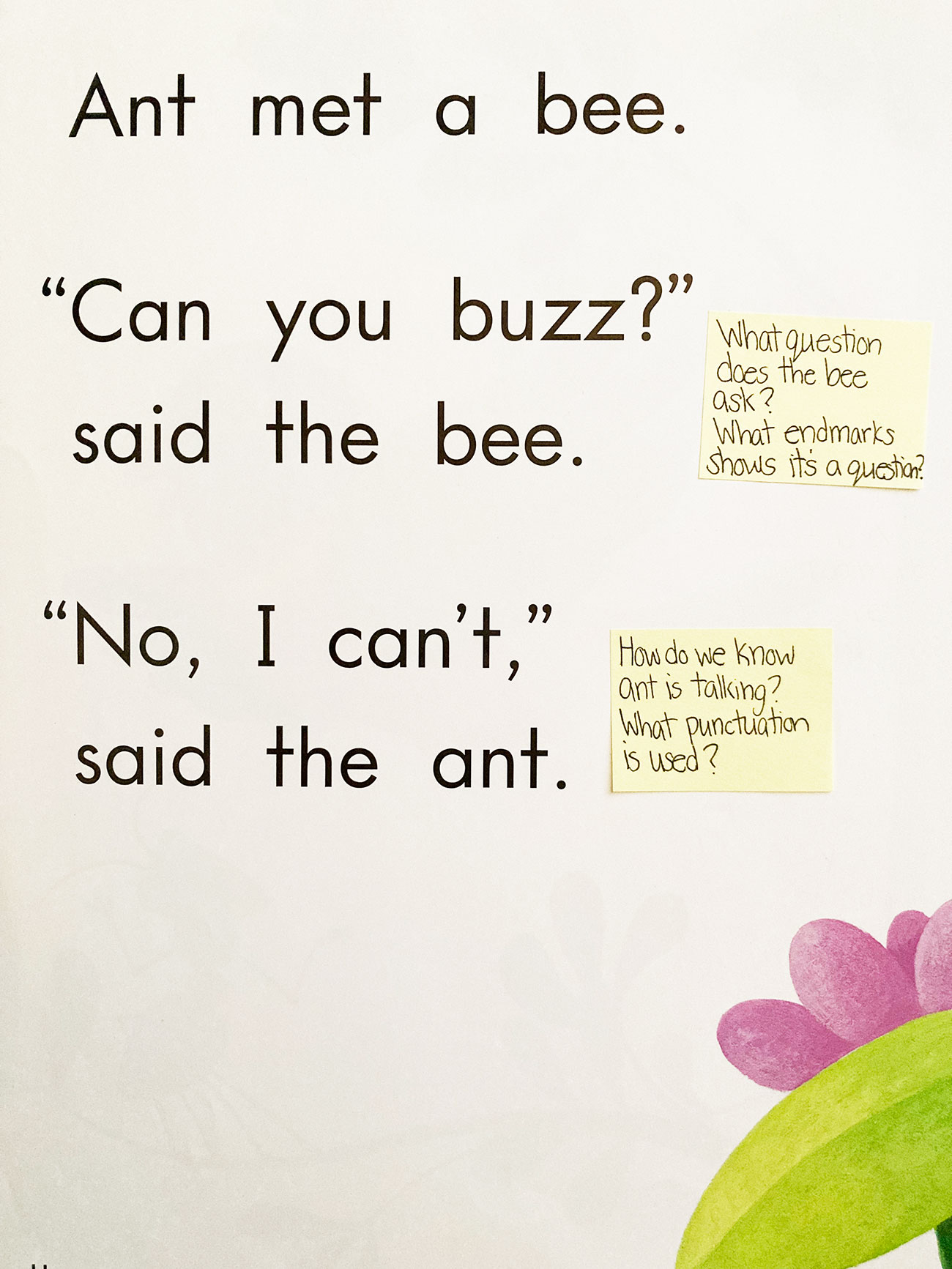
Then you can extend the learning by pointing out the new convention you plan to teach: “How do we know Ant is talking? What punctuation is used around Ant’s words?”
The remaining pages of the text can be used to reinforce the convention you’d like to see students’ apply to their own writing.
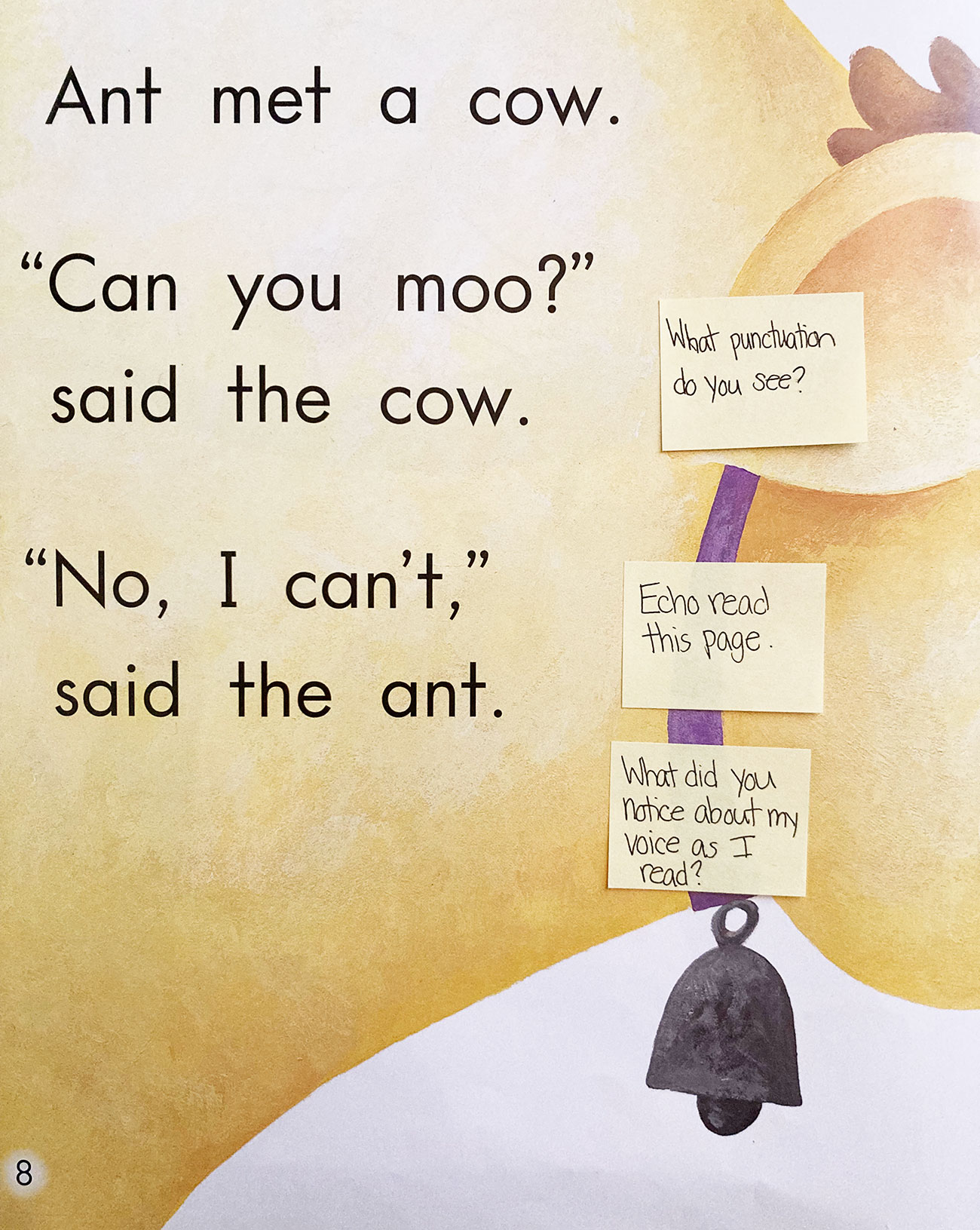
For the last page or two of the predictable book, you may want to have students add the “missing” punctuation to the page by writing on the Post-it tape you placed prior to the lesson. Students can tell what is “missing” on the page and then you can have a volunteer pull off the Post-it® tape in a grand reveal.
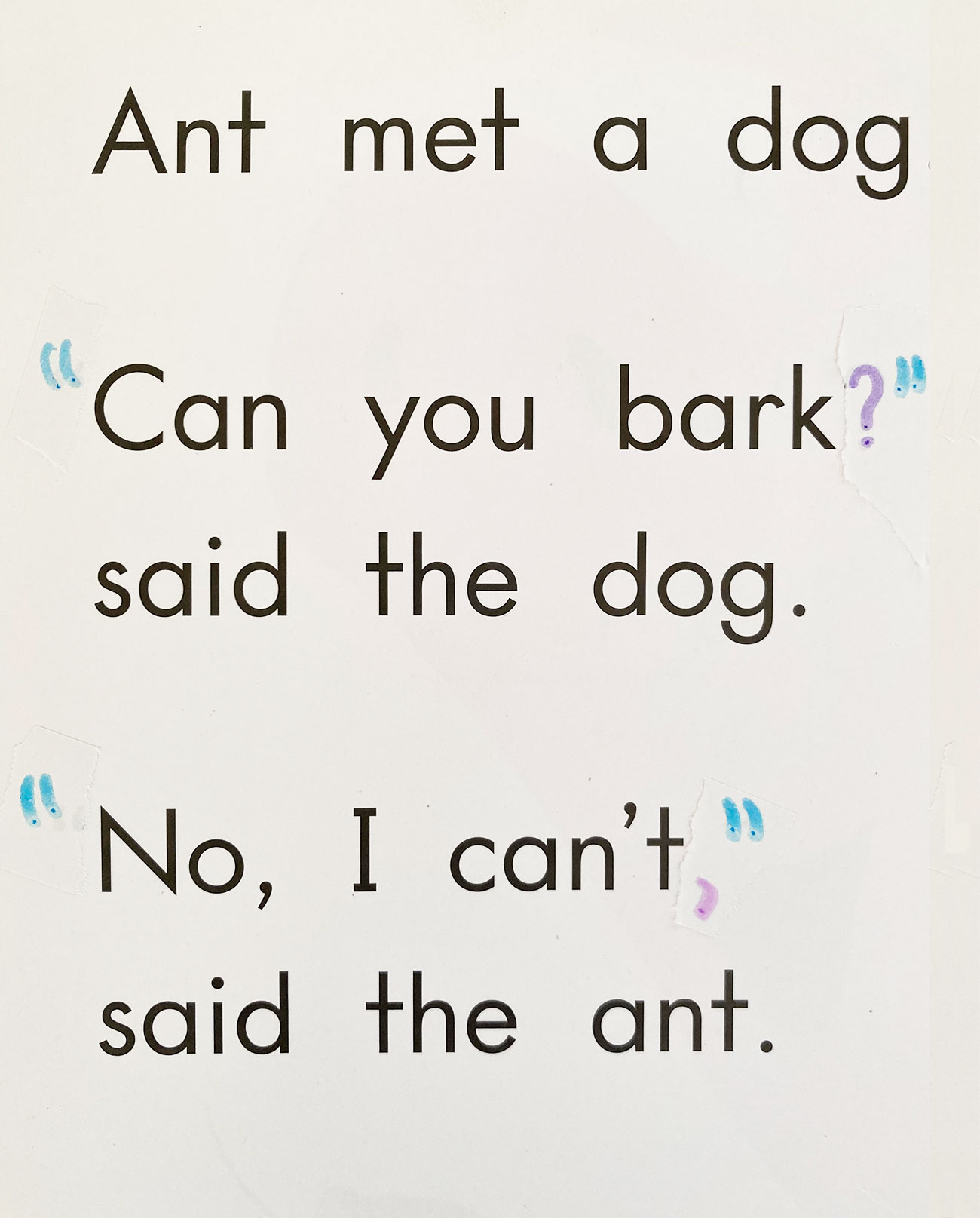
To support application of the convention, you may want to give students a photocopy of a page or two of the book so each child can “write in the book” before they then look in their own written pieces for opportunities to apply the convention.
7. You can spell that again!
For this activity, the best texts to use have a single sentence per page and a pattern that includes recently taught high-frequency words.

Use small Post-it® notes, or cut larger ones down to size, so that the targeted words can be covered without obscuring the rest of the text.
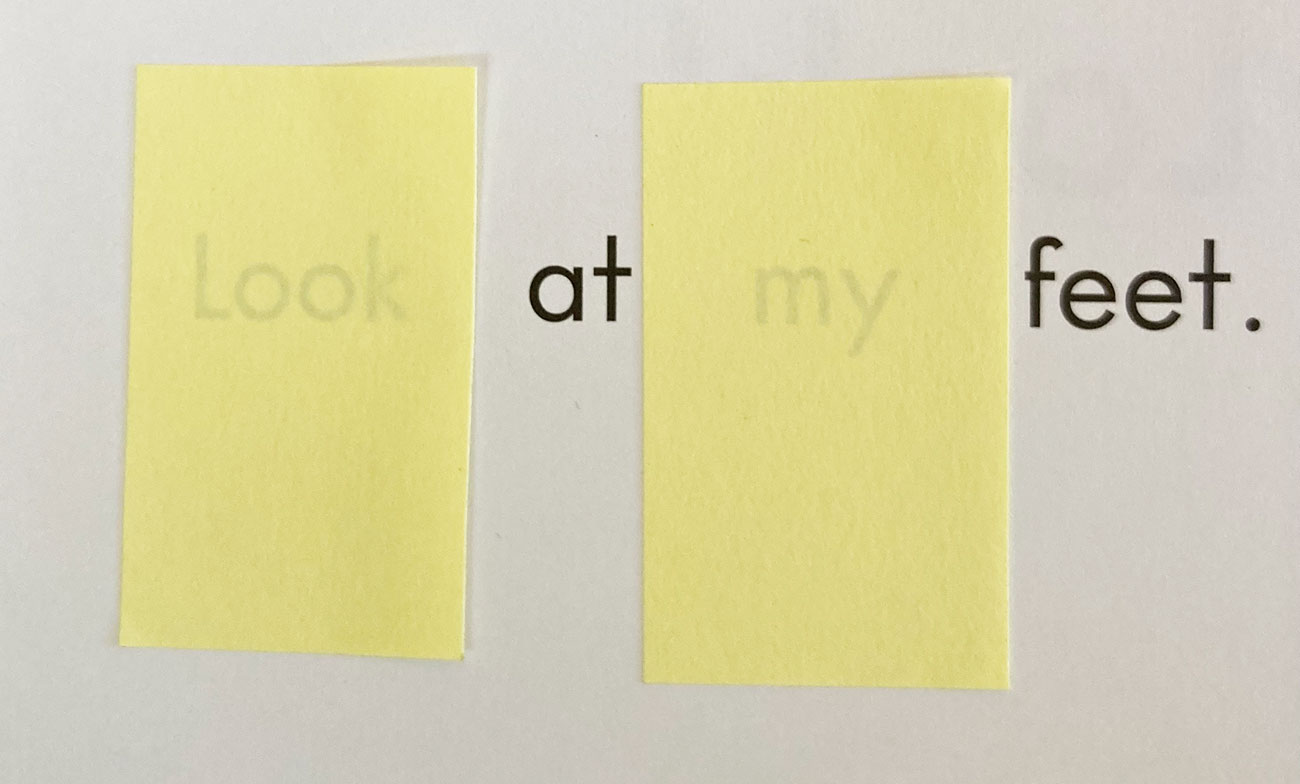
The targeted words will be slightly visible, which will offer a scaffold for when students write the words.
Once they have been taught the procedure, students can complete each step of the lesson during Literacy Centers. A single student can do all the steps for a single book, or children at the center can rotate books after each step.
When you first introduce the activity, explain the routine by briefly modeling each of the steps:
1. Look carefully at each page. If you see one of your targeted words, say the word and cover it with a Post-it® note.
2. Optional: (Swap books with a classmate when you are both done covering your target words.)
3. You can peek under the Post-it® notes if you aren’t sure about the word, but say the word and its letters as you write: “Look, L-o-o-k, Look.” “My, m-y, my.”
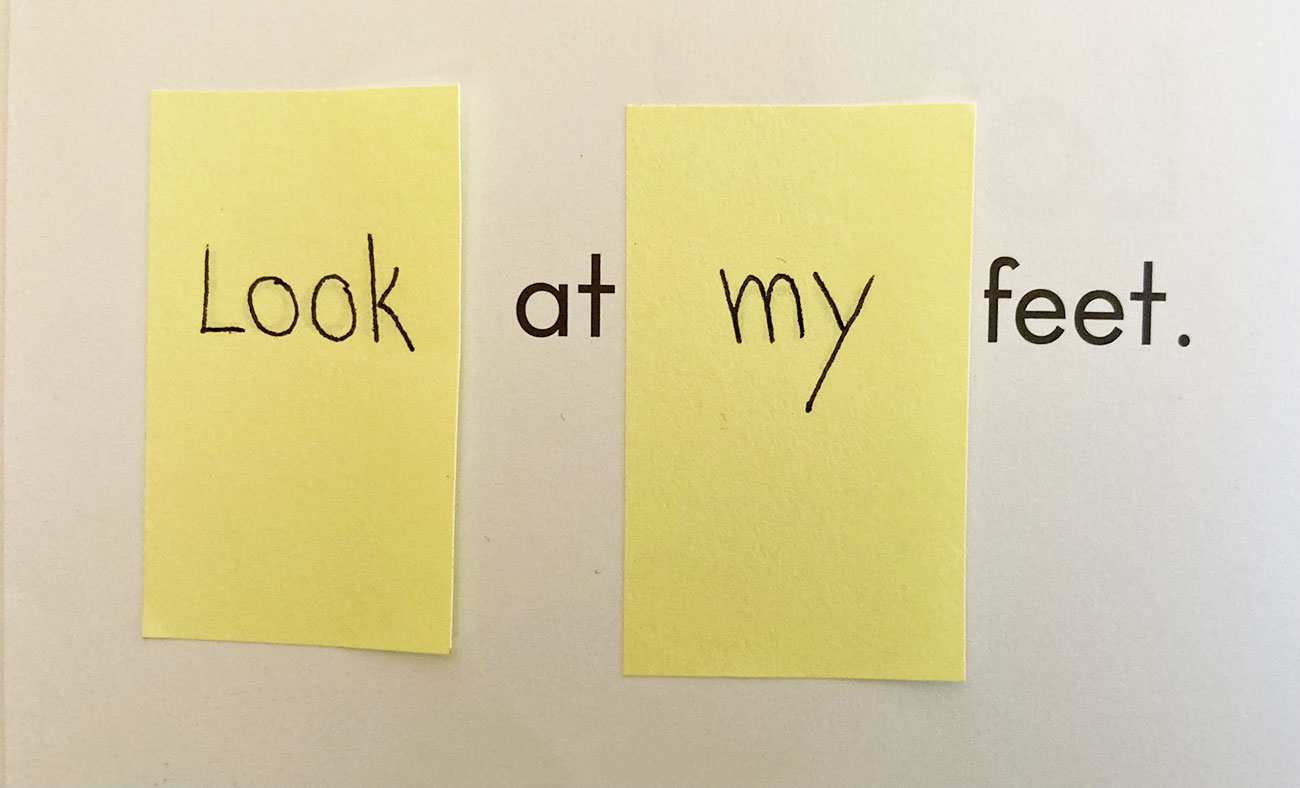
After you have written all the targeted words in the book:
4. Optional: (Swap books with a classmate when you are both finished writing your target words.)
5. Pull off the Post-it® notes, reading each one aloud.
6. Optional: Organize the Post-it® notes to graph the high-frequency words and determine which word appeared most frequently.
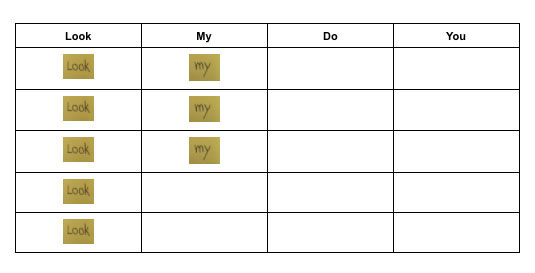
8. Turn the page
Books that have a cumulative pattern work best for this activity because they provide many opportunities for repetition. For example, in the Level A book, Waking Up!, each page introduces a new farm animal and all previously introduced animals appear in the background.

To begin the activity, read the first page aloud, show the accompanying picture. You might seize the opportunity to have students share the word for the image in their home language. Then, introduce the targeted English vocabulary word. With the book Waking Up!, you might point to the picture, and have them repeat after you, “cow.”
Then, introduce a sentence frame and have the students finish the frame with the targeted vocabulary. For example, “Here is the cow.”
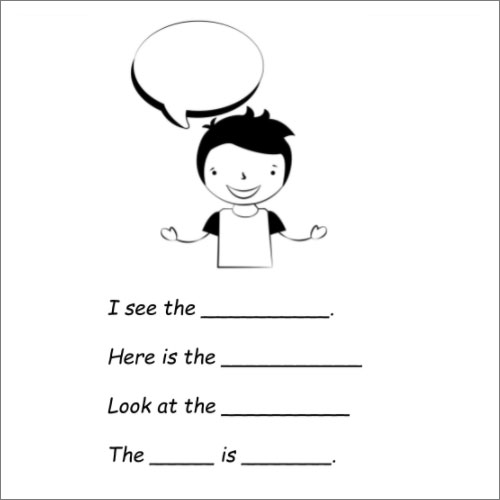
Then, show the next page of the book. Ask a question, such as “Where is the cow?” and invite a student to point to the picture and say the sentence they practiced aloud, “Here is the cow.”
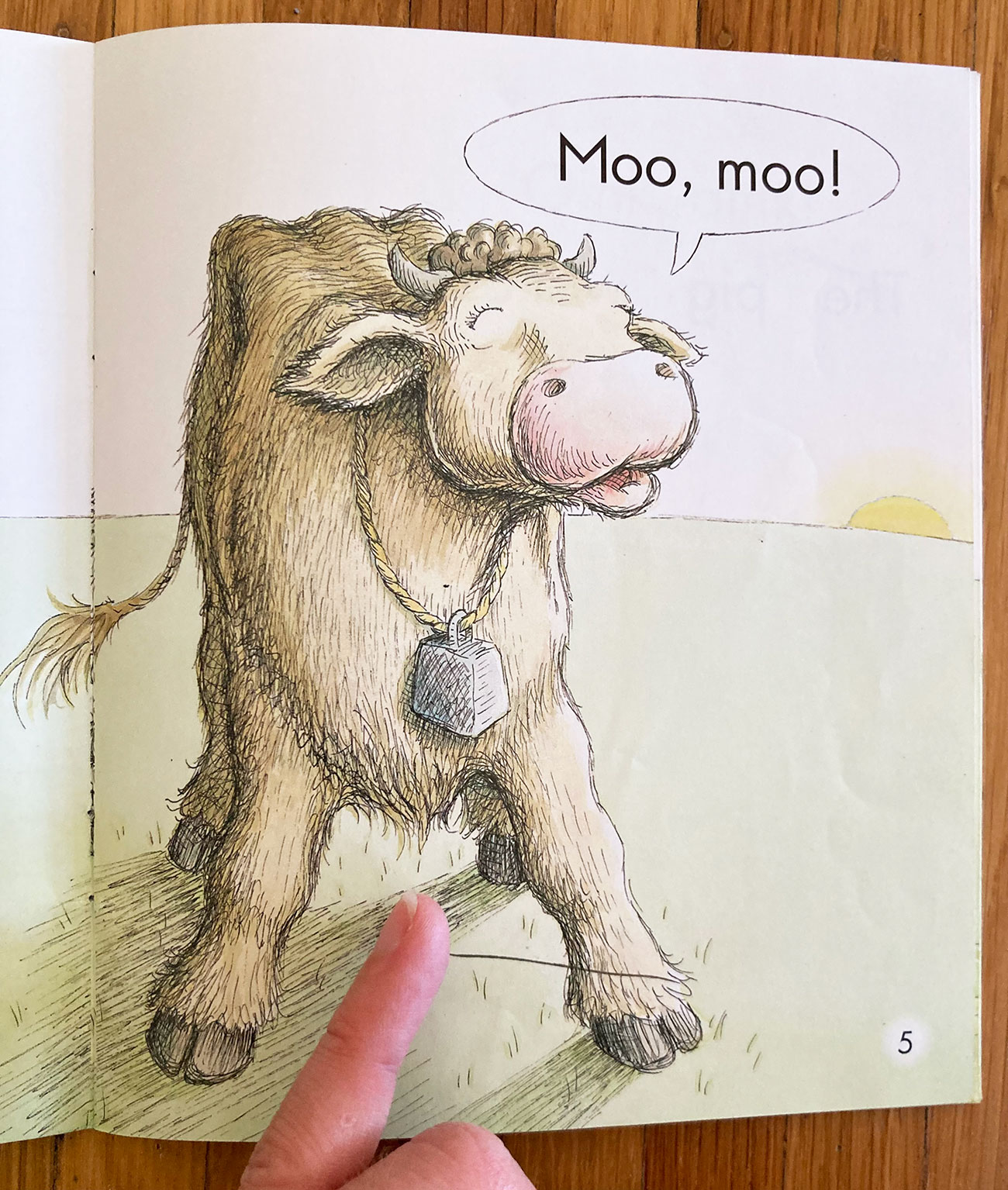
Repeat the procedure for subsequent pages to ensure students are confident saying the sentence.
Then, flip back in the book to introduce the second vocabulary word on the first page it appears and introduce the word. You might use the same sentence frame, “Here is the pig.” or, if students are ready, introduce a new frame, “Look at the pig.”
Then, invite a student to repeat the new sentence while pointing to the page.
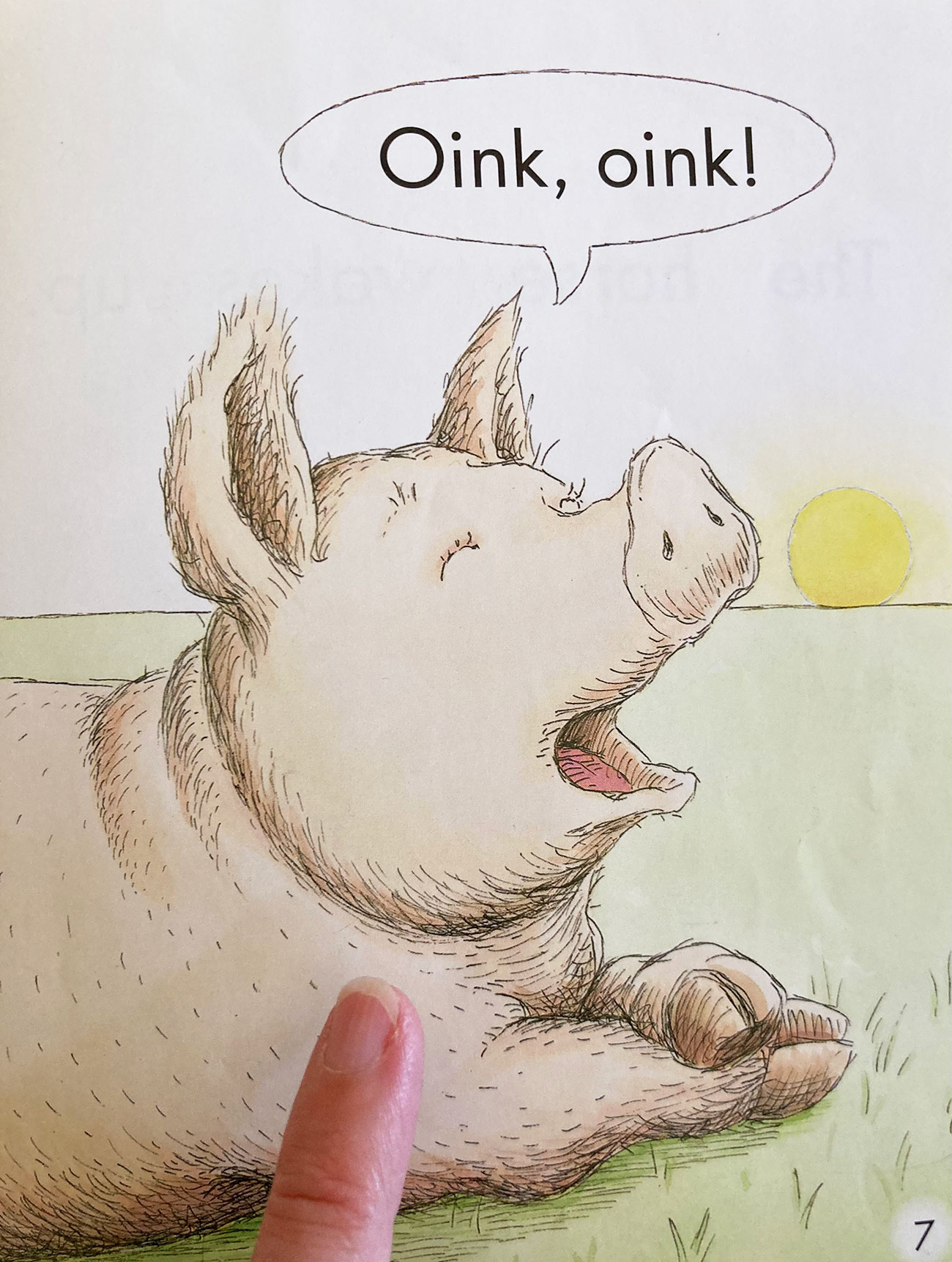
Prompt for the previous sentence by asking a question like, “Where is the cow?”
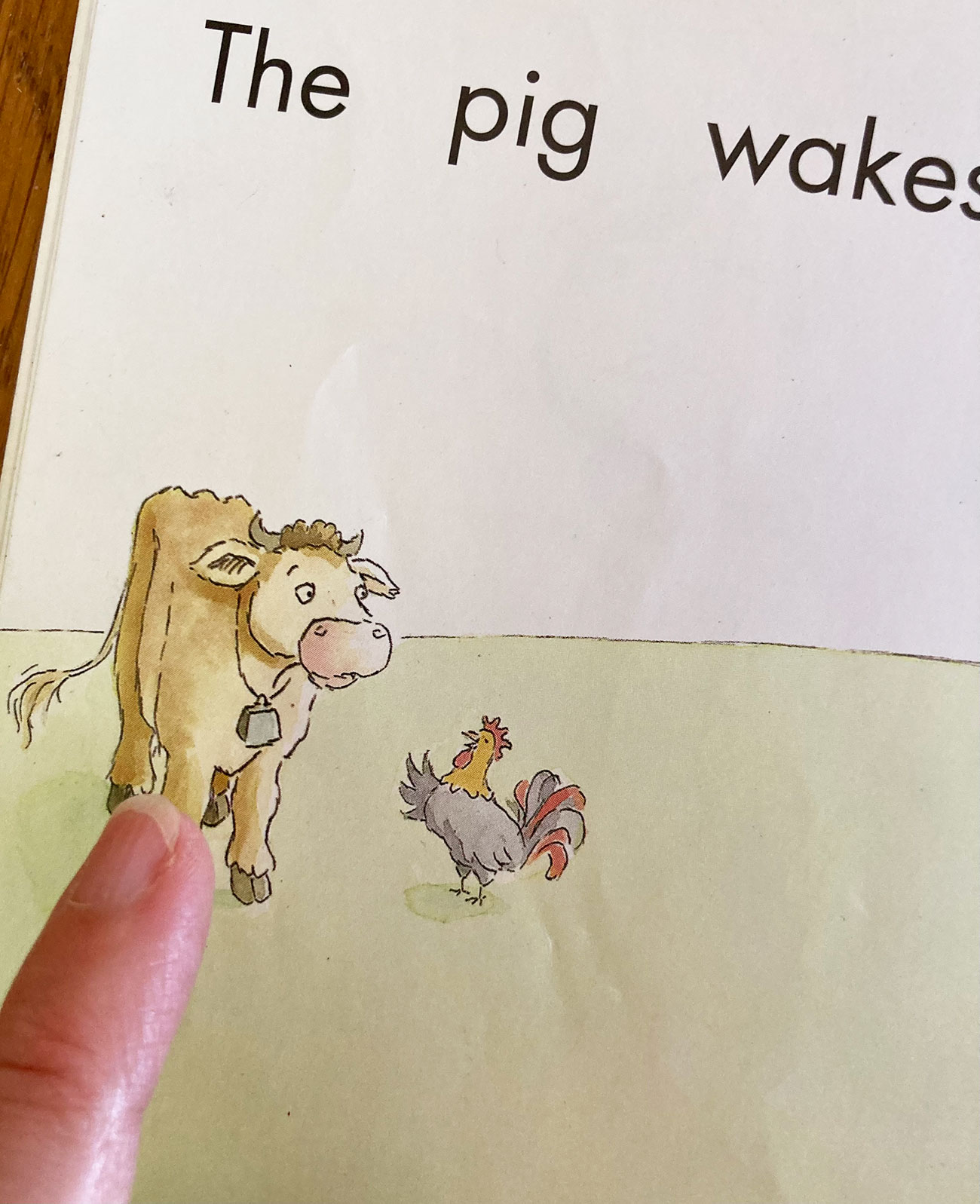
As you share the rest of the book, you can alternate your prompts — “Where is the cow?” “Do you see a pig?” — and add in new vocabulary and sentence frames to ensure students respond in complete sentences and extend their language as they are ready.
9. Picture this!
Low-level books (A-D) that are focused on themes your class is already studying, may work well for this activity because the pictures tend to be easy to identify.
 With younger students learning about modes of transportation, you might select topic-related words less likely to be in students’ spoken vocabulary, such as trolley or snowmobile. With older students studying a similar topic, you might also look for opportunities to teach morphology using words students can read, such as unicycle, bicycle, and tricycle, which include the meaningful word parts uni-, bi-, tri-, and cycle.
With younger students learning about modes of transportation, you might select topic-related words less likely to be in students’ spoken vocabulary, such as trolley or snowmobile. With older students studying a similar topic, you might also look for opportunities to teach morphology using words students can read, such as unicycle, bicycle, and tricycle, which include the meaningful word parts uni-, bi-, tri-, and cycle.
Depending on your students’ language skills, you might provide sentence frames to have them describe the targeted vocabulary words or have them use the picture and their knowledge of the object to co-construct a definition. For example, “A bicycle has two wheels and you peddle to make the bike move.”
10. A (labeled) picture is worth a thousand words
Students can practice their fine motor skills while cutting out pictures and words from the books. Once they have cut out the items they want for their collage, you or a volunteer can check to ensure that the work has been done carefully.

Then, students can be given glue sticks and blank paper to finish their collages.
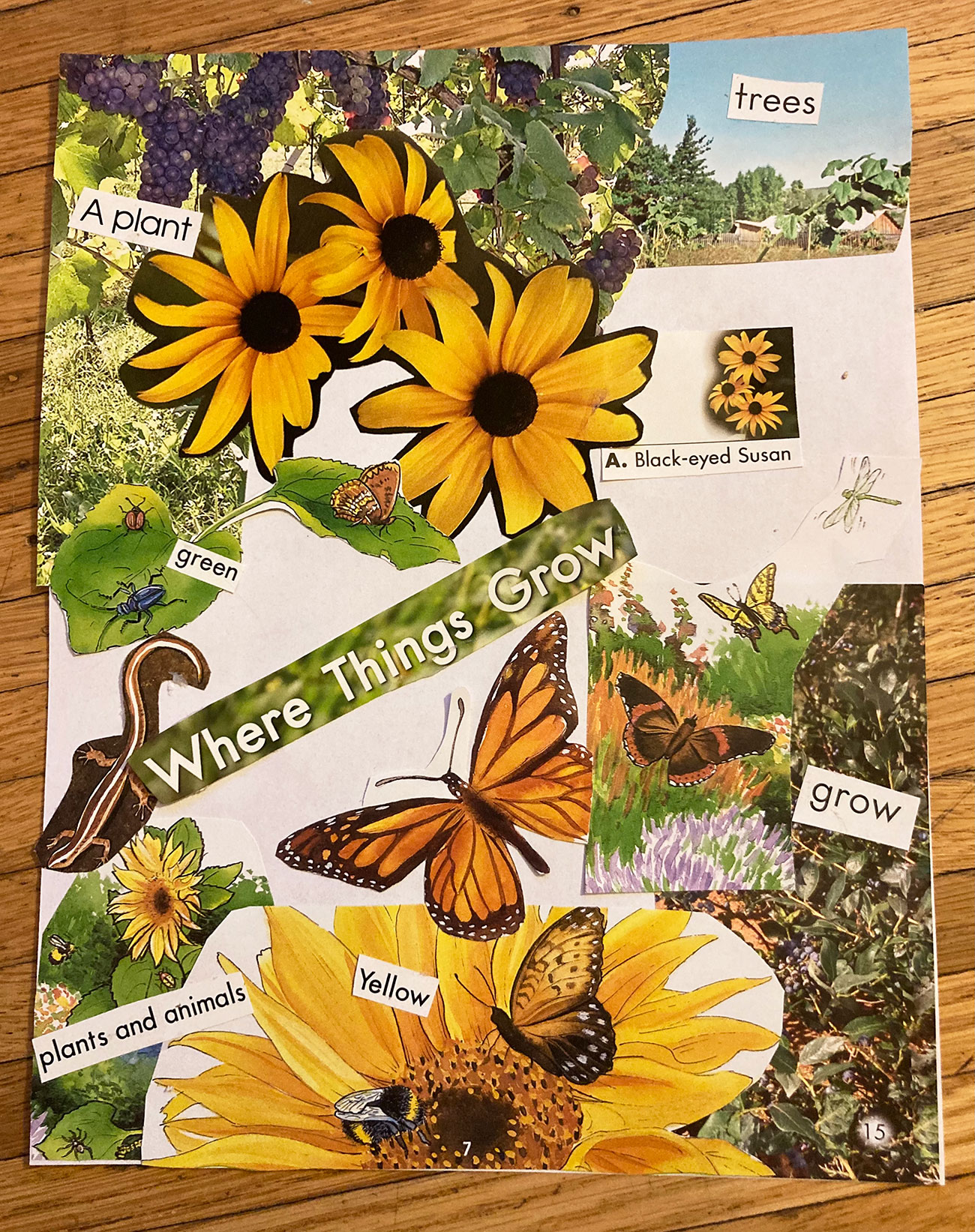
When students have finished their pieces, you might invite them to talk about their creations in an “Artist’s Chair” or with partners. Discussing labelled collages offers an opportunity to use academic sentence frames such as:
“The theme I chose is ___.”
“I selected __ because __.”
“Something I appreciate about your work is __.”

